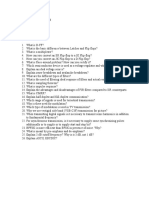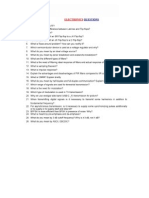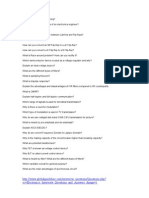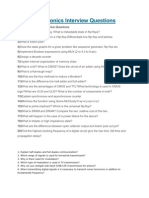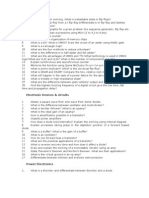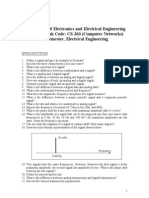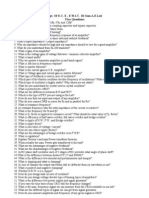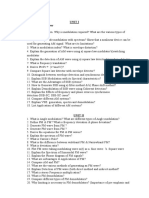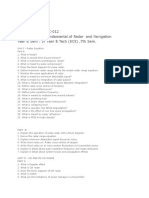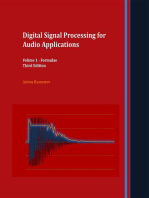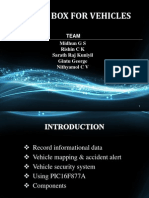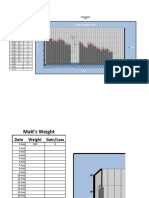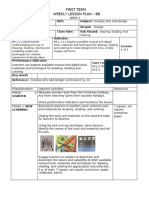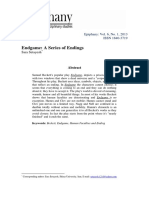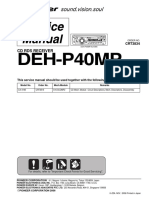Re: Electronics and Communication Engineering Core Interview Questions. - 11-03
Re: Electronics and Communication Engineering Core Interview Questions. - 11-03
Uploaded by
Akshat AnandCopyright:
Available Formats
Re: Electronics and Communication Engineering Core Interview Questions. - 11-03
Re: Electronics and Communication Engineering Core Interview Questions. - 11-03
Uploaded by
Akshat AnandOriginal Description:
Original Title
Copyright
Available Formats
Share this document
Did you find this document useful?
Is this content inappropriate?
Copyright:
Available Formats
Re: Electronics and Communication Engineering Core Interview Questions. - 11-03
Re: Electronics and Communication Engineering Core Interview Questions. - 11-03
Uploaded by
Akshat AnandCopyright:
Available Formats
Re: Electronics and communication engineering core interview questions.
- 11-032007, 08:57 PM Some of the questions I got this season in interviews are 1. What is hole theory? 2. What is avalanche effect? 3. Difference between CDMA and GSM? 4. What is GPRS? How does it work? 5. Have you heard of 4th generation mobile techlogy? 6. What is S/N ratio? 7. What is transponder? 8. What are the types of soldering?
1. What is D-FF? 2. What is the basic difference between Latches and Flip flops? 3. What is a multiplexer? 4. How can you convert an SR Flip-flop to a JK Flip-flop? 5. How can you convert an JK Flip-flop to a D Flip-flop? 6. What is Race-around problem? How can you rectify it? 7. Which semiconductor device is used as a voltage regulator and why? 8. Explain an ideal voltage source? 9. Explain zener breakdown and avalanche breakdown? 10. What are the different types of filters? 11. What is the need of filtering ideal response of filters and actual response of filters? 12. What is sampling theorem? 13. What is impulse response? 14. Explain the advantages and disadvantages of FIR filters compared to IIR counterparts. 15. What is CMRR? 16. Explain half-duplex and full-duplex communication? 17. Which range of signals is used for terrestrial transmission? 18. Why is there need for modulation? 19. Which type of modulation is used in TV transmission? 20. Why we use vestigial side band (VSB-C3F) transmission for picture? 21. When transmitting digital signals is it necessary to transmit some harmonics in addition to fundamental frequency? 22. For asynchronous transmission, is it necessary to supply some synchronizing pulses additionally or to supply or to supply start and stop bit? 23. BPFSK is more efficient than BFSK in presence of noise. Why? 24. What is meant by pre-emphasis and de-emphasis? 25. Explain 3 dB cutoff frequency? Why is it 3 dB, not 1 dB? 26. Explain ASCII, EBCDIC
You might also like
- Billy T JamesDocument6 pagesBilly T JamesNorthSouthNZNo ratings yet
- A Life Thats Good Chords (Ver 3) by Lennon & Maisytabs at Ultimate Guitar ArchiveDocument2 pagesA Life Thats Good Chords (Ver 3) by Lennon & Maisytabs at Ultimate Guitar ArchivesummerludlowNo ratings yet
- Performing Sergei Rachmaninoff's All-Night VigilDocument13 pagesPerforming Sergei Rachmaninoff's All-Night VigilAlejadro Morel CoronadoNo ratings yet
- RF Interview Questions and AnswersDocument6 pagesRF Interview Questions and AnswersadnangulzarNo ratings yet
- Questions and Answers For TelephonyDocument24 pagesQuestions and Answers For TelephonyJohn Jomari BagtasNo ratings yet
- Isro, Barc Interview QuestionsDocument7 pagesIsro, Barc Interview QuestionspuppykNo ratings yet
- Bio Signal Processing Question BankDocument5 pagesBio Signal Processing Question BankMATHANKUMAR.S0% (1)
- Echolette BS40 1964Document13 pagesEcholette BS40 1964FanOfDanNo ratings yet
- Blue Devils 2014 Snare BreakDocument1 pageBlue Devils 2014 Snare BreakLarry Thomas Land100% (2)
- Kathrein Catalogue2019 PDFDocument456 pagesKathrein Catalogue2019 PDFcarlosaeserrano100% (4)
- Twelfth Night: Curriculum GuideDocument19 pagesTwelfth Night: Curriculum GuideEric Ellul100% (1)
- Basics ElectronicsDocument1 pageBasics Electronicsanilchahar14No ratings yet
- Electronic Interview QuestionsDocument1 pageElectronic Interview QuestionsSatish MbNo ratings yet
- Electronics: QuestionsDocument1 pageElectronics: QuestionsKing BookerNo ratings yet
- InterviewqueDocument1 pageInterviewqueRavi TejaNo ratings yet
- Advance Lab Viva QuestionsDocument3 pagesAdvance Lab Viva QuestionsArunmozhi SinouvassaneNo ratings yet
- Questions/Electronics Sample Questions - HTMLDocument1 pageQuestions/Electronics Sample Questions - HTMLBiju PnambiarNo ratings yet
- 6212 Technical Interview Electronics)Document1 page6212 Technical Interview Electronics)ashu1302No ratings yet
- DigitalDocument2 pagesDigitalVishwanath BrungiNo ratings yet
- Interview Technical QuestionsDocument2 pagesInterview Technical QuestionsAndreaBenjaminNo ratings yet
- Electronics and Communication Digital ElectronicsDocument20 pagesElectronics and Communication Digital ElectronicsPraveen KumarNo ratings yet
- Department of Electronics and Electrical Engineering Question Bank Code: CS-303 (Computer Networks) 8 Semester, Electrical EngineeringDocument15 pagesDepartment of Electronics and Electrical Engineering Question Bank Code: CS-303 (Computer Networks) 8 Semester, Electrical EngineeringGopikrishnan Radhakrishnan100% (1)
- LTE InterviewDocument3 pagesLTE InterviewJaved AminNo ratings yet
- Assignment - Interview Questions - ECE - 3Document4 pagesAssignment - Interview Questions - ECE - 3JitheshNo ratings yet
- Ec 3 Lab Viva QuestionsDocument4 pagesEc 3 Lab Viva QuestionsDeepti Chandrasekharan0% (1)
- Comprehensive Viva QuestionsDocument9 pagesComprehensive Viva Questionsraju83650% (2)
- Ec2045 Satellite CommunicationDocument6 pagesEc2045 Satellite CommunicationSeekay Alais Karuppaiah CNo ratings yet
- Frequently Asked DSP Interview QuestionsDocument2 pagesFrequently Asked DSP Interview QuestionspremurNo ratings yet
- DCCN Model Question-TheoryDocument13 pagesDCCN Model Question-TheoryChirag ParasharNo ratings yet
- Question Bank For Eletronic Design PracticesDocument9 pagesQuestion Bank For Eletronic Design PracticesabcdNo ratings yet
- DSP FAQ - Frequently Asked DSP Interview QuestionsDocument2 pagesDSP FAQ - Frequently Asked DSP Interview Questionssurendra_maliNo ratings yet
- Sample Question Bank: Frto ExamDocument6 pagesSample Question Bank: Frto ExamDIP100% (1)
- Rating View AnswerDocument3 pagesRating View AnswerNavdeep AhlawatNo ratings yet
- Principles of Communication Question BankDocument8 pagesPrinciples of Communication Question BankShaniya FathimuthuNo ratings yet
- ECE Interview QuestionsDocument2 pagesECE Interview QuestionsJoshua Dusari100% (1)
- DSP Lab Sample Viva QuestionsDocument10 pagesDSP Lab Sample Viva QuestionsManish NarkhedeNo ratings yet
- Digital Communications - Viva Voce QuestionsDocument3 pagesDigital Communications - Viva Voce QuestionsAllanki Sanyasi Rao100% (1)
- Viva Qns AECDocument2 pagesViva Qns AECRoopaliNayak100% (1)
- Analog and Digital CommunicationDocument2 pagesAnalog and Digital CommunicationnabarunpvtNo ratings yet
- EC6801 IT Wireless CommunicationDocument10 pagesEC6801 IT Wireless CommunicationAnbu ArasanNo ratings yet
- ADC - Question Bank Long QuestionsDocument3 pagesADC - Question Bank Long QuestionsBhuma VenkateshNo ratings yet
- DSP Lab Sample Viva QuestionsDocument7 pagesDSP Lab Sample Viva QuestionsNikoBellicNo ratings yet
- EC6801 IT WirelessCommunicationquestionbankDocument10 pagesEC6801 IT WirelessCommunicationquestionbankEASACOLLEGENo ratings yet
- Optical Networks QBDocument6 pagesOptical Networks QBPreethi MuraliNo ratings yet
- PD QuesDocument32 pagesPD Quessunkara naga hari prasadNo ratings yet
- Cseitquestions - Blogspot.In Cseitquestions - Blogs Pot - in Cseitquestions - Blogspot.InDocument23 pagesCseitquestions - Blogspot.In Cseitquestions - Blogs Pot - in Cseitquestions - Blogspot.IndeepikaNo ratings yet
- Adc Imp Ques Mid-IDocument1 pageAdc Imp Ques Mid-IsainilakantanNo ratings yet
- Analog and Digital CommunicationDocument9 pagesAnalog and Digital CommunicationManish MahasethNo ratings yet
- Interview QuesDocument12 pagesInterview Quesvlsi_asicNo ratings yet
- LTE 4G Question Bank-15EC81 PDFDocument8 pagesLTE 4G Question Bank-15EC81 PDFRoopa NayakNo ratings yet
- DSP Viva Questions PDFDocument4 pagesDSP Viva Questions PDFMallikharjuna GoruNo ratings yet
- 2 Marks PDFDocument5 pages2 Marks PDFBala913No ratings yet
- Viva QuestionsDocument13 pagesViva QuestionsSwathi KoteshwarNo ratings yet
- QP Bank Communication SystemDocument3 pagesQP Bank Communication Systemmahimathesh97No ratings yet
- Sample QADocument4 pagesSample QAmohammadbaig337405No ratings yet
- Astable Multivibrators Are Used in Amateur Radio Equipment To Receive and Transmit RadioDocument9 pagesAstable Multivibrators Are Used in Amateur Radio Equipment To Receive and Transmit RadioMichell RobinsonNo ratings yet
- C C C C !!Document7 pagesC C C C !!guruvigneshwaranNo ratings yet
- Viva Voce Questions: Subject Code: Ec2405 Sem / Year: Vii / IvDocument5 pagesViva Voce Questions: Subject Code: Ec2405 Sem / Year: Vii / IvSarika VadivelanNo ratings yet
- Telemetry Question BankDocument5 pagesTelemetry Question BankMATHANKUMAR.SNo ratings yet
- PCOMDocument6 pagesPCOMShruthi BhatNo ratings yet
- Question Bank Subject Code: TEC-012 Subject Name: Fundamental of Radar and Navigation Year & Sem: IV Year B.Tech (ECE), 7th SemDocument4 pagesQuestion Bank Subject Code: TEC-012 Subject Name: Fundamental of Radar and Navigation Year & Sem: IV Year B.Tech (ECE), 7th Semkumar_csunilNo ratings yet
- Viva - Voce Model QuestionsDocument2 pagesViva - Voce Model QuestionsbharathiNo ratings yet
- Viva Questions For Advanced Communication LabDocument4 pagesViva Questions For Advanced Communication Labanittadevadas57% (7)
- Ferranti EffectDocument3 pagesFerranti EffectMutaharZahidNo ratings yet
- VLSI Interview QuestionDocument17 pagesVLSI Interview QuestionamiteshtripathiNo ratings yet
- Quiz Electronic Communication (2151004)Document2 pagesQuiz Electronic Communication (2151004)Sneha PandyaNo ratings yet
- Viva QuestionsDocument11 pagesViva QuestionsRaj Kumar0% (1)
- Digital Signal Processing for Audio Applications: Volume 1 - FormulaeFrom EverandDigital Signal Processing for Audio Applications: Volume 1 - FormulaeNo ratings yet
- Submitted byDocument21 pagesSubmitted byAkshat AnandNo ratings yet
- Analytical Reasoning TipsDocument14 pagesAnalytical Reasoning TipsNaveed Ali Shah100% (2)
- Black Box For Vehicles: Team Midhun G S Rishin C K Sarath Raj Kuniyil Gintu George Nithyamol C VDocument28 pagesBlack Box For Vehicles: Team Midhun G S Rishin C K Sarath Raj Kuniyil Gintu George Nithyamol C VAkshat AnandNo ratings yet
- Eddy Current BrakesDocument25 pagesEddy Current BrakesRadu Lucian AlexandruNo ratings yet
- Weight ChartDocument4 pagesWeight Chartspottersmitty30No ratings yet
- Ekp b1 PreviewDocument8 pagesEkp b1 PreviewcumicaNo ratings yet
- August 31, 2013Document2 pagesAugust 31, 2013lansingchurchNo ratings yet
- Closed LoopDocument19 pagesClosed Loopammar120100% (1)
- USB Device Compatible List For Prolink WNR1011Document4 pagesUSB Device Compatible List For Prolink WNR1011hatottsugmailNo ratings yet
- B8 Cad Term1 AllDocument43 pagesB8 Cad Term1 AllJOSAN HomeNo ratings yet
- #The Daily Telegrams Dec 03Document4 pages#The Daily Telegrams Dec 03sudhasurya420No ratings yet
- Narrative Lectionary Worship 2017-2018Document15 pagesNarrative Lectionary Worship 2017-2018Phillip MorganNo ratings yet
- Soundiron - Alpha Organ - User Manual - v1.0Document18 pagesSoundiron - Alpha Organ - User Manual - v1.0Lala RiriNo ratings yet
- Basic Block Diagram of MTI Radar System:: 1-Transmitting Section 2 - Receiving SectionDocument5 pagesBasic Block Diagram of MTI Radar System:: 1-Transmitting Section 2 - Receiving Sectionjaveria100% (1)
- Endgame A Series of EndingsDocument11 pagesEndgame A Series of EndingsRosa GiacomobelloNo ratings yet
- PHD Practical GuideDocument16 pagesPHD Practical GuideAnonymous qBWLnoqBNo ratings yet
- 1 Alumni Homecoming Fellowship 1 Alumni Homecoming FellowshipDocument2 pages1 Alumni Homecoming Fellowship 1 Alumni Homecoming FellowshipJerome VerbaNo ratings yet
- Soja ReceptDocument3 pagesSoja ReceptjasminaNo ratings yet
- Charlie's AriaDocument7 pagesCharlie's AriaAndrew DurhamNo ratings yet
- Siemens Relay 7rw600Document20 pagesSiemens Relay 7rw600rajinipre-1No ratings yet
- Pioneer DEH-P40MP PDFDocument70 pagesPioneer DEH-P40MP PDFМилорад НожинићNo ratings yet
- Birdsong and Music David MatthewsDocument7 pagesBirdsong and Music David MatthewsClaudio Maioli100% (1)
- Chapter SummariesDocument1 pageChapter SummarieseddielawNo ratings yet
- 1124227Document28 pages1124227buddha91No ratings yet
- CM TP PHYv3.0 I06 110310Document436 pagesCM TP PHYv3.0 I06 110310ff78501No ratings yet
- RespectDocument1 pageRespectRosalia UrbanoNo ratings yet











